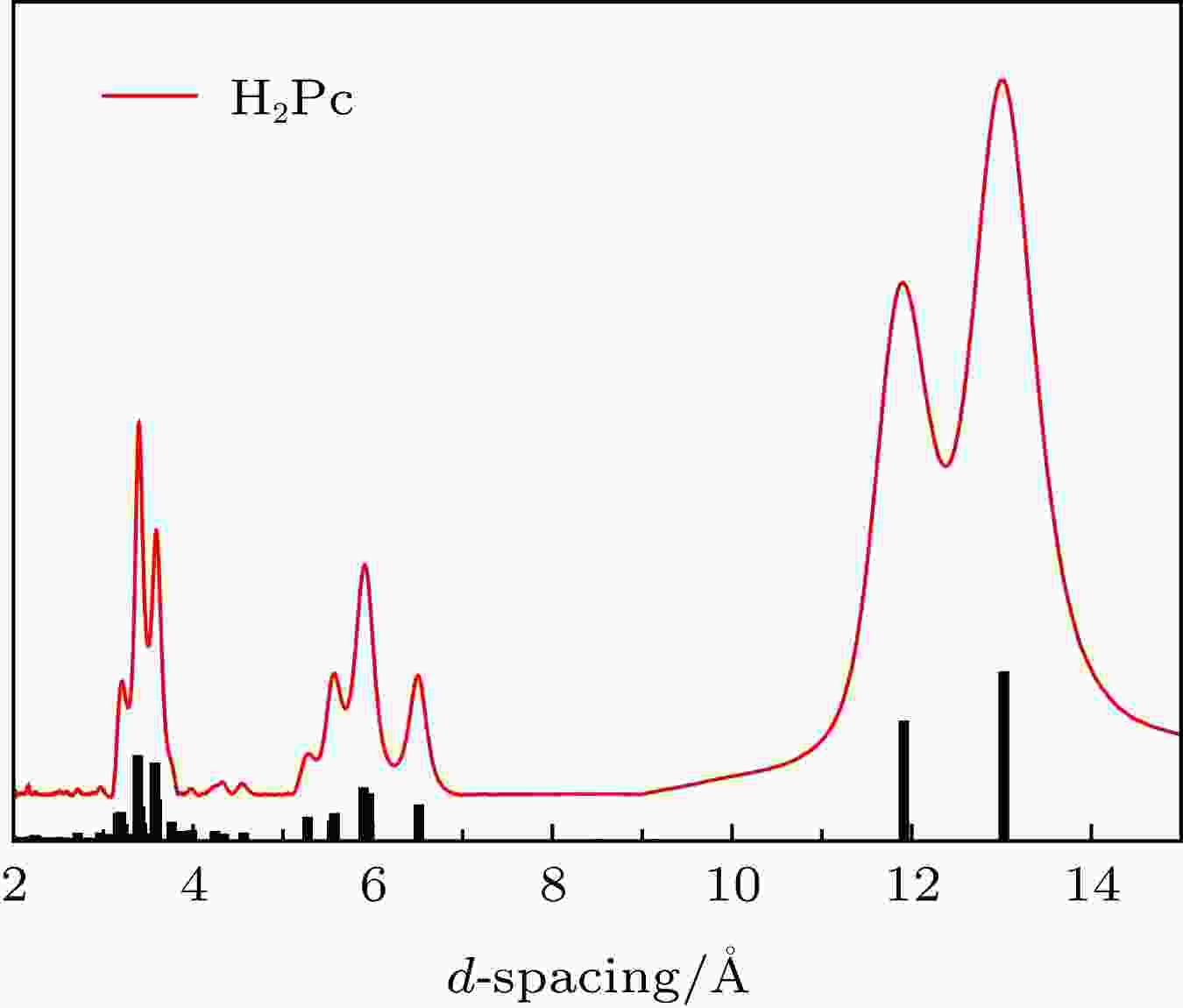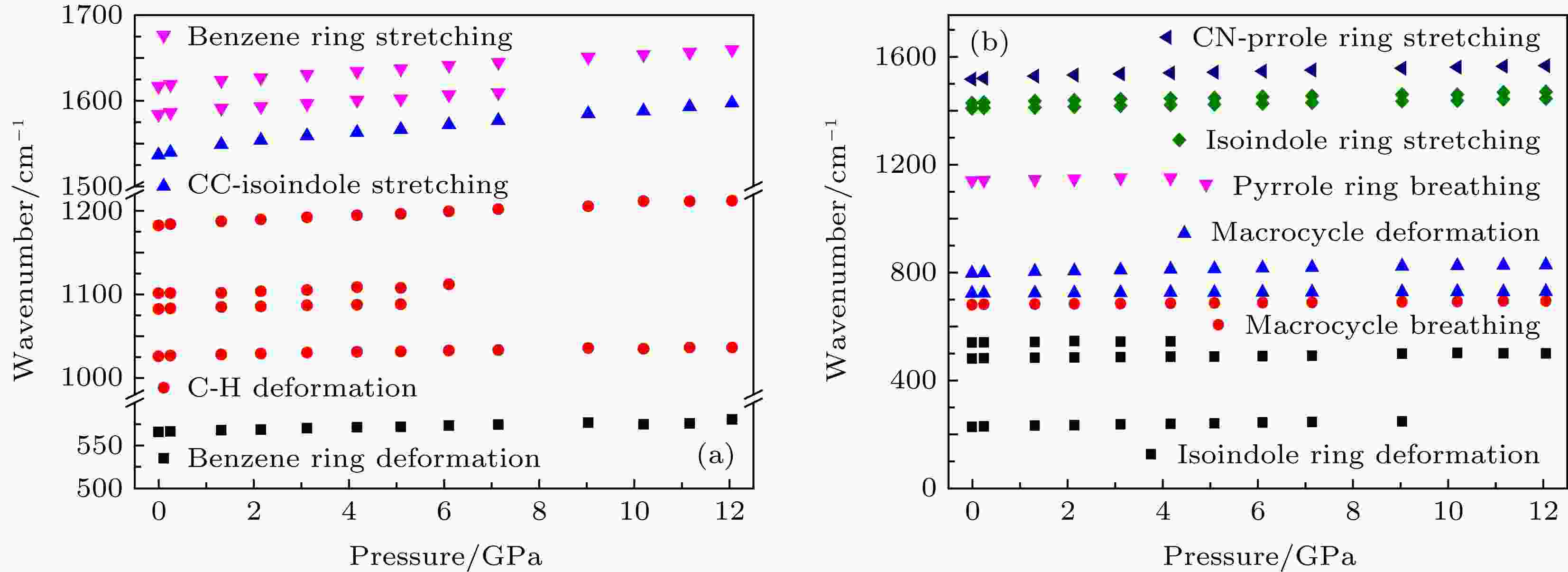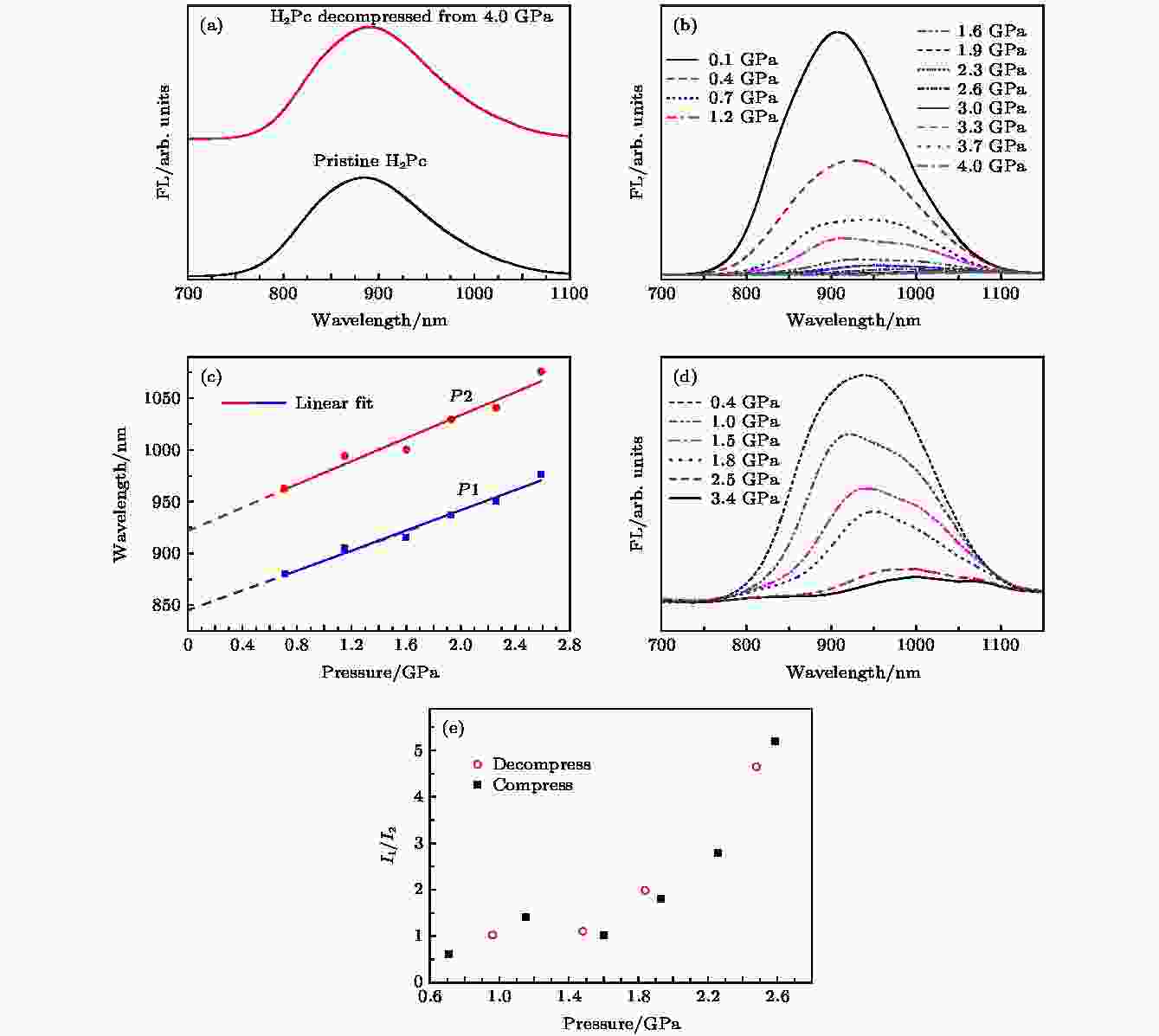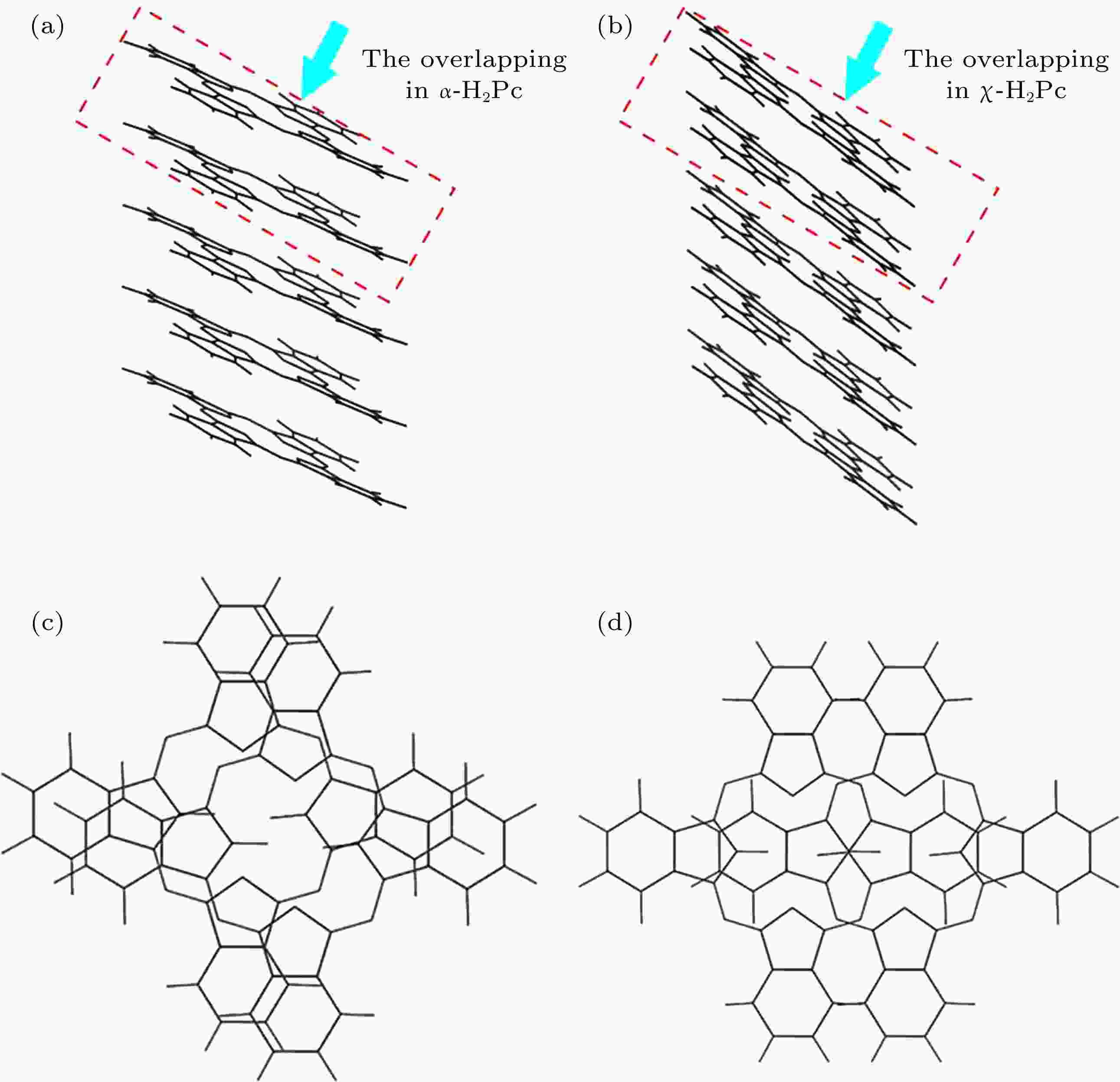全文HTML
--> --> -->| α相 | β相 | χ相 | |
| 空间群 | C2/n | P21/n | Pna21 |
| 晶系 | 单斜 | 单斜 | 正交 |
| a/nm | 2.6124(3) | 1.4796(6) | 2.10(1) |
| b/nm | 0.3801(1) | 0.47325(6) | 0.491(5) |
| c/nm | 2.3889(3) | 1.7357(7) | 2.31(1) |
| α/(°) | 90 | 90 | 90 |
| β/(°) | 94.18(2) | 104.32(2) | 90 |
| γ/(°) | 90 | 90 | 90 |
表1酞菁α相[3]、β相[1]和χ相[1]的晶体结构信息
Table1.Structural parameters of different phases of metal-free phthalocyanine[1,3].
高压可以改变分子间的距离、排布方式及相互作用, 进而实现对分子体系物理性质的调控, 一些有机分子材料如四苯乙烯等表现出压致变色和压致荧光增强的现象[9-12]. Grenoble和Drickamer[13]研究了酞菁在高压下电子结构的变化, 发现在17.5 GPa范围内随着压力的增加酞菁本身的吸收峰向低能区移动, 认为在17.5 GPa压力范围内酞菁仍保持α相. 目前酞菁晶体的高压研究仍处于起步阶段, 高压下的结构与物性研究尚不完善.
本工作利用高压原位拉曼技术对酞菁在高压下的结构相变进行了研究. 研究发现, 在压力达到12.0 GPa时酞菁分子结构仍保持稳定, 没有发生开环反应. 酞菁晶体在压力作用下逐渐由α相转变为χ相, 这一转变卸压后可逆. 同时还对酞菁的高压荧光光谱进行了研究, 发现其光谱强度随压力增高而衰减, 至3.0 GPa时消失. 进一步分析表明, 高压下酞菁分子间的激基缔合物荧光受抑制, 常压下α相酞菁中观察不到的酞菁分子荧光在高压下出现. 我们认为酞菁荧光性质的变化应归因于酞菁晶体中呈平行排列的分子之间在压力下重叠程度减小.
2.1.试剂与仪器
实验所使用的酞菁购自阿拉丁试剂(中国)有限公司(编号P160721), 传压介质使用氯化钠, 购买自阿法埃莎(天津)化学有限公司(Alfa Aesar, 编号A12313), 用红宝石做压力标定物.X射线衍射(XRD)测试使用的是日本理学的MicroMax-007HF微区XRD衍射仪, 靶材为铜, 波长为0.15406 nm, 拉曼和荧光均使用HORIBA LabRAM HR Evolution 拉曼光谱仪进行测试, 激发光波长为473 nm. 高压实验在金刚石对顶砧装置中完成, 拉曼测试所使用的压机金刚石砧面大小为500 μm, 荧光测试所使用的压机金刚石砧面大小为600 μm. 高压试验所使用的垫片材质为T301钢.
2
2.2.实验过程
压机准备与装样: 将T301钢片预压至60 μm厚, 在压痕中央打一个孔作为样品腔(拉曼测试中孔直径为160 μm, 荧光测试孔直径为230 μm). 将垫片复位后, 先在下砧面点一颗直径20 μm的红宝石, 然后用氯化钠填满样品腔并压实, 之后刮去部分氯化钠, 装入样品, 最后再在样品上覆盖一层氯化钠, 完成装样. 随后进行加压和拉曼光谱、荧光光谱的测试.3.1.样品XRD表征
图1是样品的常压微区XRD测试结果, 根据文献[3]中报道的α相酞菁晶体结构数据, 利用Materials Studio中的Reflex模块计算了α相酞菁的XRD (图中黑色竖线), 样品α相酞菁的峰位、峰强与计算结果符合得很好, 说明样品是α相酞菁. 图 1 样品的XRD表征.黑色竖线是利用文献[3]中α相酞菁晶体结构计算出的结果
图 1 样品的XRD表征.黑色竖线是利用文献[3]中α相酞菁晶体结构计算出的结果Figure1. The XRD pattern of sample under ambient pressure. The black lines are from calculation result of α phase metal-free phthalocyanine (α-H2Pc)[3]
2
3.2.样品拉曼表征
图2(a)中黑线为酞菁的拉曼光谱测试结果, 其中常压的酞菁拉曼光谱中的所有拉曼振动峰均能被指认并归属于α相酞菁[14,15], 这与XRD测试结果一致. 其中, 130 cm–1处的振动峰为大环平面外变形振动模式, 185 cm–1为异吲哚基团的同相振动模式, 206, 228, 481, 519和540 cm–1为异吲哚环变形振动模式, 556 cm–1为苯环变形振动模式, 680 cm–1为大环呼吸振动模式, 722和796 cm–1为大环变形振动模式, 1008, 1026, 1082, 1105, 1183和1229 cm–1均为碳氢振动模式, 1140和1336 cm–1为吡咯环呼吸振动模式, 1407和1427 cm–1为异吲哚环伸缩振动模式, 1516 cm–1为吡咯环中的碳氮伸缩振动模式, 1536 cm–1为吡咯环中的碳碳伸缩振动模式, 1584和1618 cm–1为苯环伸缩模式. 图2(b)为酞菁高压原位拉曼光谱测试结果. 我们发现随着压力的升高, 归属于α相酞菁的拉曼振动模式的峰强逐渐减弱, 大部分振动模式都保留到了最高压力. 位于600—800 cm–1范围内的三个拉曼峰代表着酞菁分子大环的振动模式, 均保持到了最高压力, 表明酞菁的大环结构保持到了12.0 GPa, 并未发生开环反应. 当压力达到1.3 GPa时, 位于130 cm–1附近代表大环平面外变形振动模式的拉曼峰消失, 说明大环平面外变形振动受到了明显的抑制. 由于大环本身结构在高压下得到保持, 我们认为大环平面外变形振动受抑制的原因是高压下酞菁分子间距离减小所导致的. 值得注意的是, 大多数的酞菁拉曼峰的强度随着压力的增加而减弱, 但是在623 cm–1处的拉曼峰的强度随着压力增加而增强(图2(c)). 根据文献报道, 这个拉曼峰对应着酞菁分子的B1g振动模式, 只有在χ相中才能被观察到[14,15]. 因此我们认为在压力的作用下α相酞菁逐渐转变为χ相. 图2(a)中的红线是卸压后的酞菁拉曼光谱, 与常压的对比, 卸压后归属于χ相的B1g拉曼振动峰消失, 图中各拉曼振动峰与α相一致, 说明α相酞菁向χ相的转变是可逆的. 我们还对高压下酞菁的拉曼峰位随压力变化的情况进行了分析, 如图3所示, 结果发现高压下绝大多数酞菁拉曼峰的峰位随压力的增加逐渐往高波数移动, 这种峰位随压力的变化是线性的, 不存在突变, 表明压力诱导的α相酞菁向χ相的转变随压力增加的渐变过程. 高压拉曼光谱数据表明, 酞菁分子在12.0 GPa的压力下仍保持稳定, 压力会使酞菁分子间距离逐渐缩小, 并诱导α相酞菁逐渐向χ相转变. 常压下χ相的密度(1.44 g/cm3)大于α相(1.43 g/cm3), 在高压下样品的体积会被压缩, 使得样品的密度随压力增大而变大, 因此高压下α相和χ相酞菁密度均会大于其常压下的密度. 在实验中观察到压力诱导酞菁α相向χ相转变, 因此我们认为χ相的密度大于α相, 为酞菁的高密度相. 实验中所使用的氯化钠起到传压介质的作用, 提供非静水性环境, 从拉曼光谱中可以看出在实验的压力范围内氯化钠与酞菁之间没有明显的化学反应. 而氯化钠所提供的非静水性环境可能促进α相酞菁的相变发生, 这与文献[13]一致. 图 2 样品拉曼光谱测试 (a) 常压与卸压样品的拉曼光谱; (b) 酞菁的高压拉曼光谱; (c) 峰位为623 cm–1的拉曼峰随着压力升高峰强增强
图 2 样品拉曼光谱测试 (a) 常压与卸压样品的拉曼光谱; (b) 酞菁的高压拉曼光谱; (c) 峰位为623 cm–1的拉曼峰随着压力升高峰强增强Figure2. The Raman spectra of α-H2Pc: (a) The Raman spectra of sample at ambient pressure and decompressed from 12.0 GPa; (b) the Raman spectra of α-H2Pc under high pressure; (c) the Raman peak around 623 cm–1 under high pressure
 图 3 样品的拉曼峰位随压力的变化
图 3 样品的拉曼峰位随压力的变化Figure3. The Raman frequency of H2Pc as functions of pressure.
2
3.3.样品的荧光表征
图4(a)中的黑线数据是酞菁常压荧光光谱测试结果. 在473 nm的激光激发下, α相酞菁有一个荧光中心, 位置为 885 nm, 这与文献中报道的α相酞菁粉末的荧光光谱基本一致[8], 是酞菁分子间激基缔合物的荧光. 图5(b)是酞菁高压原位荧光光谱测试结果. 高压下酞菁的荧光峰位发生红移, 荧光强度逐渐减弱, 至3.0 GPa时荧光几乎完全消失. 注意到压力达到0.7 GPa时酞菁的荧光光谱有两个明显的荧光中心, 我们对0.7 GPa和更高压力的荧光数据进行高斯拟合, 结果如图4(b)所示. 在0.7—2.6 GPa压力范围内, 荧光光谱中都存在两个荧光中心, 将能量较高的荧光中心称为P1, 能量较低的荧光中心称为P2, 我们发现P1和P2的峰位随压力的变化是近线性的, 对P1和P2的峰位随压力的变化进行线性拟合得到两条直线L1和L2 (如图4(c)中蓝色和红色的实线所示). 将L1和L2外推至常压(如图4(c)中蓝色和红色的虚线所示), 得到常压下P1与P2所对应的峰位分别为(844 ± 4) nm和(922 ± 11) nm, 能量差约为0.12 eV, 与Menzel等[8]报道的χ相酞菁中815和900 nm两个荧光中心(能量差约0.14 eV)接近, 因此我们认为P1和P2所代表的荧光中心与Menzel等[8]报道的χ相两个荧光中心有相同的来源, 即P1是酞菁分子荧光, 而P2是酞菁分子间激基缔合物的荧光. 卸压过程的酞菁荧光光谱如图4(d)所示, 卸压过程中随着压力的降低酞菁荧光强度逐渐增强. 图4(a)中的红线是卸压后的酞菁荧光谱, 卸压至常压后酞菁的荧光峰中心在890 nm, 与常压相比有5 nm的红移. 图 4 样品的荧光光谱 (a)样品的常压和卸压荧光光谱; (b) 样品的升压荧光光谱; (c) 样品的荧光中心随压力的变化及其线性拟合, 虚线为线性拟合所得直线的延长线; (d) 样品卸压过程中的荧光光谱; (e) 两个荧光中心的峰强比随压力的变化图
图 4 样品的荧光光谱 (a)样品的常压和卸压荧光光谱; (b) 样品的升压荧光光谱; (c) 样品的荧光中心随压力的变化及其线性拟合, 虚线为线性拟合所得直线的延长线; (d) 样品卸压过程中的荧光光谱; (e) 两个荧光中心的峰强比随压力的变化图Figure4. The fluorescence (FL) spectra of α-H2Pc: (a) The FL spectra of α-H2Pc at ambient pressure (black line) and decompressed from 4.0 GPa (red line); (b) the FL spectra of α-H2Pc under high pressure during compressing; (c) the blue and red dots are the position of P1 and P2 during compressing, the blue and red lines are the linear fitting between the position and pressure, and the dash lines are the extension of the blue and red line; (d) the FL spectra of α-H2Pc under high pressure during decompressing; (e) the intensity ratio of P1 and P2 under high pressure
 图 5 α相和χ相酞菁的分子排布和重叠程度示意图 (a) α相酞菁的分子排布; (b) χ相酞菁的分子排布; (c) α相酞菁的分子重叠程度; (d) χ相酞菁的分子重叠程度
图 5 α相和χ相酞菁的分子排布和重叠程度示意图 (a) α相酞菁的分子排布; (b) χ相酞菁的分子排布; (c) α相酞菁的分子重叠程度; (d) χ相酞菁的分子重叠程度Figure5. The arrangement and overlapping of PC molecules in α-H2Pc and χ-H2Pc: (a) The arrangement of Pc molecules in α-H2Pc; (b) the arrangement of Pc molecules in χ-H2Pc; (c) the overlapping of Pc molecules in α-H2Pc; (d) the overlapping of Pc molecules in χ-H2Pc [1,3].
